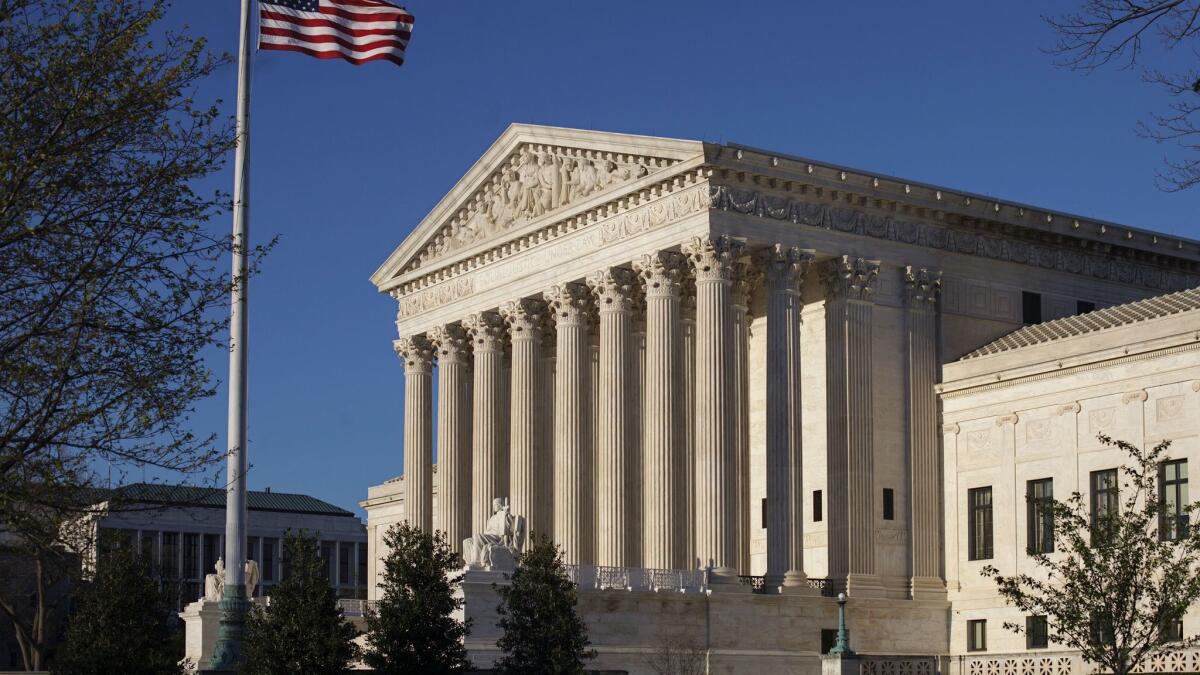Supreme Court turns down gerrymander appeal from Pennsylvania’s GOP

- Share via
Reporting from Washington — The Supreme Court refused Monday to block a new election map for Pennsylvania that gives Democrats a chance to win four or more congressional seats in November.
The justices turned down a second and final appeal from Pennsylvania’s Republican leaders, who defended the gerrymandered districts that had given them a steady 13-5 advantage over the Democrats for years.
The new map gives Democrats a good chance to win half of the 18 House seats. Last week, they celebrated picking up a Republican seat when Conor Lamb claimed victory in a special election for a seat in southwestern Pennsylvania. Republicans have not conceded that race as final provisional ballots are counted.
Lamb and all other candidates will run this fall in districts that have been redrawn.
The Supreme Court acted Monday afternoon shortly after a panel of three federal judges in Harrisburg, Pa., refused to block the new election map drawn at the behest of the Pennsylvania Supreme Court. In late January, the state justices ruled the gerrymandered map drawn in 2011 was unduly partisan and denied voters their right to a free and equal election. They chose Stanford Law professor Nate Persily to draw a new election map with districts that were more compact.
Having lost in the state courts, Republican leaders of the state legislature tried two last-minute appeals in the federal courts. They sued in Harrisburg, arguing the state judges had overstepped their power. But the three judges — all Republican appointees — decided the state legislators did not speak for the legislature as a whole and did not have standing to sue.
They also tried again in the U.S. Supreme Court. On Feb. 5, the court had quickly turned away an appeal of the state court ruling. But on Feb. 27, lawyers for Michael Turzai, a Republican leader and speaker of the state House, filed an emergency appeal with Justice Samuel A. Alito Jr., urging the high court to block the new state map.
They argued the state court had violated a provision in the U.S. Constitution that says the “Times, Places and Manners of holding Elections for Senators and Representatives shall be prescribed in each state by the Legislature thereof.” They said only state lawmakers, not the state high court, can draw the election districts for members of the House.
This idea has appeal among the court’s conservatives, including Chief Justice John G. Roberts Jr. He dissented in 2015 when the court ruled that Arizona’s voter-approved independent commission could draw its congressional districts, despite the opposition of the Republican-controlled legislature. Justices Alito, Clarence Thomas and the late Antonin Scalia agreed.
But in the past, the Supreme Court had written opinions joined by Scalia and Thomas saying the states and their judges, not federal courts, should play the lead role in redrawing election districts.
For nearly three weeks, the Supreme Court took no action on the final appeal from the Pennsylvania GOP. The long delay suggests the justices were sharply divided on how to proceed. It would been taken five votes to block the new state map, and Justice Anthony M. Kennedy had joined the 5-4 ruling in the Arizona case.
On Monday afternoon, the court issued a one-line order in the case of Turzai et al. vs. League of Women Voters. “The application for stay presented to Justice Alito and by him referred to the court is denied.”
Micah Sims, executive director of Common Cause Pennsylvania, called the outcome “a victory for Pennsylvania voters who will now be able to cast ballots for congressional candidates in districts not unconstitutionally manipulated to make them uncompetitive.”
The high court will have more to say on the issue of partisan gerrymandering. In early October, the justices heard arguments in a Wisconsin case where Democrats are challenging state election districts that all but guaranteed the GOP would win super-majority control of the House, even in years when Democrats won a statewide majority.
A ruling in the case, Gill vs. Whitford, could come at any time. This week, the justices said they will issue decisions on Tuesday and Wednesday.
Major questions before the Supreme Court this year »
Twitter: DavidGSavage
UPDATES:
2:45 p.m.: The article was updated with reaction and background.
The article was originally published at 12:45 p.m.
More to Read
Get the L.A. Times Politics newsletter
Deeply reported insights into legislation, politics and policy from Sacramento, Washington and beyond. In your inbox twice per week.
You may occasionally receive promotional content from the Los Angeles Times.











